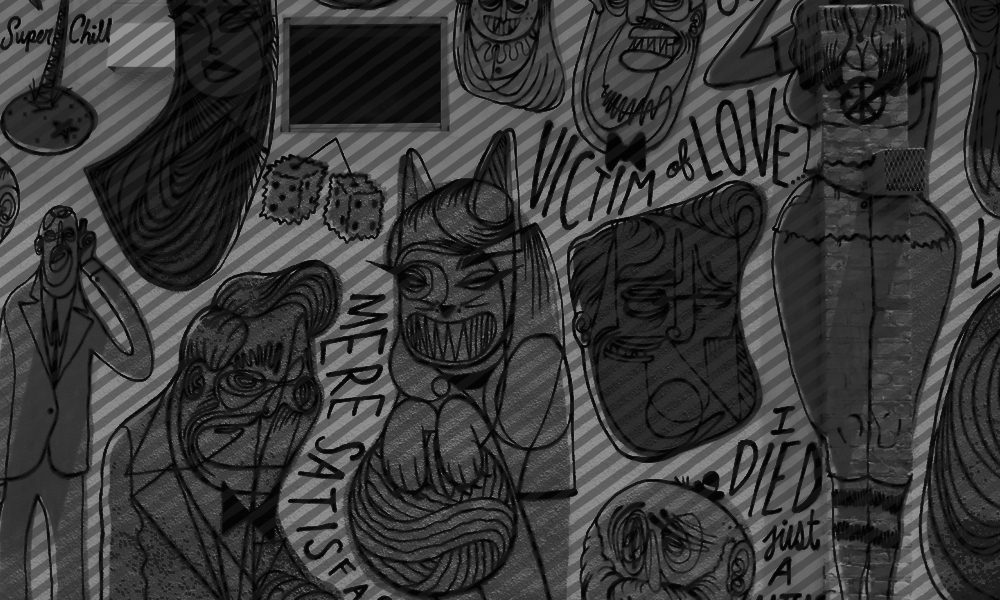This is Not A…
by Stephanie Trott & Erin Vachon
I remember wondering how the images had been placed there and why we didn’t just take them back out into the light with us.
Sarah Minor, Bright Archive
What is on the line in your writing? Jumping into image play—even if it’s an adventure we’ve explored before—can feel risky! We fret: How will I classify this piece of writing? We worry: Will anyone publish this weird creature I’ve made? We doubt: I’m not a hybrid writer. I’m not a visual artist. I’m not a poet or a novelist. We draw lines around our ideas of ourselves and our work as artists before we even begin. What are we really doing? We’re limiting ourselves.
When we think about the “line” in writing, we’re usually talking about a written line of prose or poetry that strings letters to create words and words to create phrases. The movement of the eye across the page, word by word. In the visual arts, the line of an image is the stroke of the brush, the flick of a pencil, an outline against space. Jumping across the boundary from writing in traditional form to image play means noticing how line and space are building blocks in both mediums. By putting them in conversation with each other, you’re opening up a fuller conversation on the page.
Sometimes it feels like the marks we make on the page or the words we type are set in stone. Times New Roman. Twelve-point font. Double-spaced, please. Playing with images is an opportunity to notice that this format is just that: one choice out of many. Perhaps the work we’re dying to get out into the world just won’t work inside of those borders. We have to get loose, shake off the feeling that we’re “not doing it right” in order to find its heart.
When Erin was in school in the ’90s, tape art became a craze across her home state of Rhode Island: giant blue tape art across institutional buildings in flash-in-the-pan social critique, mostly created by students. The drawings never stayed up for more than 24 hours, elaborate creations coming down in long trails of sticky cerulean. Fifth-graders and graduate students on equal artistic footing, the whole affair in garbage bins at the end of the day. Meanwhile, Stephanie was busy drawing on herself and her friends with Milky pens in New Jersey. Pastels and metallics, bold jewel tones, every color beautiful on the arms and legs and hands of countless little Jersey girls who didn’t realize how intimate an art they were creating (or how mad their moms would be when they got home after school).
A current Etch-a-Sketch artist crafts nostalgic art, each toy canvas relying on one perfect path of aluminum powder. Whether the final product is an anime character or Van Gogh’s Starry Night, Princess Etch says, “There’s something really special about shaking away the drawing and just letting go of it.”
Jane Allison’s brilliant craft book Meander, Spiral, Explode: Design and Pattern in Narrative is an exercise in patterning narratives after the natural world, specifically how a reader experiences a story: “Rather than expecting the ‘soul’ or animating shape of fiction to be a plotted arc, why not imagine other shapes? The arc makes sense for tragedy, but fiction can be wildly other.”
Feel free to approach this weekend with the freedom of children ripping down tape at the end, or drawing on your friend’s arm, or clearing an Etch-a-Sketch board: free from judgment and full of joy. This workshop is an open space for you to imagine new shapes for your writing and your writer-self, in whatever form you choose, in whatever way feels good.
Part of what we are doing in this class is noticing what we notice and noticing more, but doing it in a natural way as we move through our day.
Lynda Barry, Syllabus
Start Your Engines!
Note: During this workshop, we encourage you to work with a writing utensil and paper (as opposed to typing on a computer). Pen, pencil, crayon, marker: whatever you pick is your choice. Don’t feel you need to fuss over paper, either, unless you have some that you’ve been itching to use just for this workshop!
What lines have you drawn around your writing? Make a list of anxieties that hold you back from using images in your writing. (You don’t have to share these with anyone!)
If those lines were removed, what would your process look like? What would you produce?
Practice Lynda Barry’s exercise in drawing a spiral (pg. 76, if you have her book). This is an exercise in “both relaxation and concentration”:
- Take a piece of paper and a writing utensil.
- Start with a dot in the center of the page.
- Slowly spiral a line around the dot, as close as you can, around and around, without touching what came before.
- While you work, focus on breathing, noticing your breath and how your body experiences your practice.
